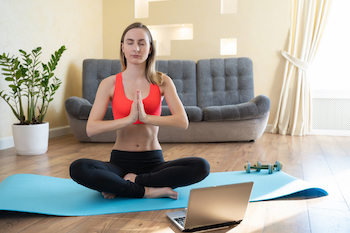 By Audra Krake, M.S., and Robyn Brinkerhoff, Ph.D., Special AFS Contributors
By Audra Krake, M.S., and Robyn Brinkerhoff, Ph.D., Special AFS Contributors
In response to widespread restrictions due to COVID-19, many fitness facilities have started offering virtual fitness classes, often publicly available to anyone on the internet, on a smart phone, or connected to a smart TV for free (and without signed liability waivers).
While such efforts present an unprecedented opportunity to engage new clients, it is also worth considering that some of the same potential injury risks that you would attempt to control when clients are using your facility are also present for people exercising at home. When performing any physical activity – whether at home, at a park, at work, or in a fitness facility – there is always an inherent risk of injury.
Within a traditional fitness studio environment, the facility typically provides resources to help novices avoid unsafe conditions during workouts. For example, expert instructors/trainers can visually  monitor patrons’ performance and correct their movements, readily answer questions regarding safe techniques, appropriate equipment, and movements to avoid, and provide spotting assistance as needed.
monitor patrons’ performance and correct their movements, readily answer questions regarding safe techniques, appropriate equipment, and movements to avoid, and provide spotting assistance as needed.
In addition, the facility layout is typically designed to appropriately space out various equipment to avoid overcrowding and reduce the likelihood of interference among different patrons and the equipment. Furthermore, facility staff can monitor areas around patrons for potential slip and trip hazards and address them with minimal interruption to the patrons’ activity.
Studies of fitness-related injuries demonstrate that they most frequently result from overexertion/undue stress placed on the body, a medical event (i.e., heart attack, syncope), slips/trips/falls, dropping/bumping into equipment, and equipment misuse (e.g., Waryasz et al., 2016; Quatman et al., 2009, Gray et al., 2015). Similar injury risks are present when working out at home as when working out at a fitness facility.
Safe performance of exercise activities depends on a variety of factors such as environmental conditions, equipment features, task difficulty, and physical characteristics of the performer. Your fitness instructors/trainers can’t control the environments, equipment, and behaviors of remote users.
They may, however, like to have suggestions and/or reminders handy to help users address frequent types of fitness-related injuries. While your instructors/trainers may have specific safety tips they typically give regarding exercise technique, some basic general tips might also be informative to users. Below are some examples of tips that could be given to help users avoid the most frequent types of fitness-related injuries, based on our own experience investigating fitness-related accidents and the scientific literature.
Safe performance of exercise activities depends on a variety of factors such as environmental conditions, equipment features, task difficulty, and physical characteristics of the performer.
Note that this list is not exhaustive, and is not meant to prescribe what your instructors/trainers should do. Rather, it is meant to give some ideas to help you think about ways you can add value to your users’ fitness experience:
- Tips to avoid overexertion/undue physical stress/medical events
- Ease into a new workout, and don’t overexert yourself
- Stay fueled and hydrated
- Warm up, cool down, and stretch properly, even if it’s not included in the guided workout
- Wear appropriate footwear (e.g., to provide sufficient cushioning if doing high impact workouts)
- Stop if you feel faint, dizzy, or experience pain
- Tips to avoid falls and bumps
- Be present and pay attention to what you are doing
- Make sure you have enough space and light to do your exercises without bumping into anything/anyone (and watch out for your pets or keep them out of the room!)
- Make sure the floor is clear of trip and slip hazards (e.g., kids’ toys, towels on a hardwood floor, spilled water)
- Wear appropriate footwear (e.g., to avoid slipping)
- If you are using furniture for stability/a support surface (e.g., a chair):
- Use furniture that is sturdy enough for your body weight so that it will not move or tip
- Check that it is the appropriate height/size for the exercise in order to minimize awkward/incorrect body position(s)
- Tips to avoid equipment-related incidents
- Check the equipment before use, and do not use if you see signs of wear or damage
- If you are using resistance bands and need to attach them to an external surface, ensure the bands are tight and secure and will not come loose when pulled
- If you use everyday household items in place of free weights make sure:
- The item is an appropriate shape – something that is easy to hold on to, and for extended periods of time (e.g., water bottle, can of beans or soup)
- The item isn’t breakable or sharp. You don’t want to use items that will increase your risk of injury should you lose control due to fatigue or a movement error
- If you are using your own equipment at home, check for warning labels on the product and/or in the user’s manual (if you have one), read them, and follow them
Robyn Brinkerhoff, Ph.D. is a human factors scientist at Exponent, a science and engineering consulting firm. She earned her Ph.D. in Cognitive Psychology from UCLA and applies her knowledge of human behavior, capabilities, and limitations to the study of how people perform in everyday situations and environments, such as while using fitness equipment or navigating public spaces. Dr. Brinkerhoff frequently acts as a consultant to investigate accidents, provide expert opinions for litigation, and advise on the development of product labels and instruction manuals.
Audra Krake, M.S. is a human factors scientist at Exponent. She earned her M.S. in Kinesiology from California State University, Long Beach, with a specialty in Exercise Science, and analyzes human factors and human performance in the context of use of consumer products, such as while using sports and exercise equipment. Ms. Krake utilizes her expertise in human movement and information-processing to evaluate issues related to motor control, decision-making, and the effects of inattention and distraction as they relate to accidents, injuries, product usage, fitness training, and technique.


Join the Conversation!